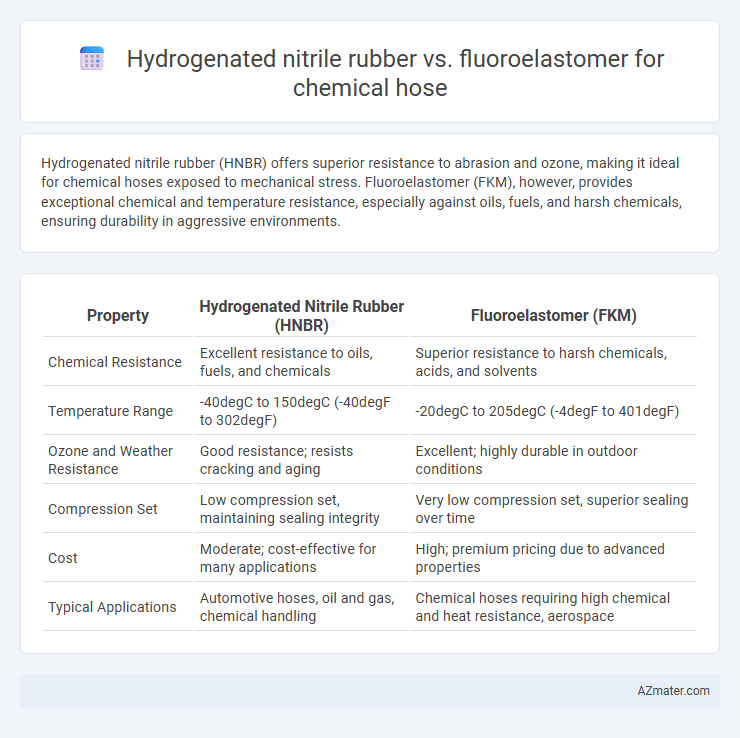Hydrogenated nitrile rubber (HNBR) offers superior resistance to abrasion and ozone, making it ideal for chemical hoses exposed to mechanical stress. Fluoroelastomer (FKM), however, provides exceptional chemical and temperature resistance, especially against oils, fuels, and harsh chemicals, ensuring durability in aggressive environments.
Table of Comparison
| Property | Hydrogenated Nitrile Rubber (HNBR) | Fluoroelastomer (FKM) |
|---|---|---|
| Chemical Resistance | Excellent resistance to oils, fuels, and chemicals | Superior resistance to harsh chemicals, acids, and solvents |
| Temperature Range | -40degC to 150degC (-40degF to 302degF) | -20degC to 205degC (-4degF to 401degF) |
| Ozone and Weather Resistance | Good resistance; resists cracking and aging | Excellent; highly durable in outdoor conditions |
| Compression Set | Low compression set, maintaining sealing integrity | Very low compression set, superior sealing over time |
| Cost | Moderate; cost-effective for many applications | High; premium pricing due to advanced properties |
| Typical Applications | Automotive hoses, oil and gas, chemical handling | Chemical hoses requiring high chemical and heat resistance, aerospace |
Introduction to Chemical Hose Materials
Hydrogenated nitrile rubber (HNBR) offers superior resistance to heat, oil, and abrasion, making it ideal for chemical hose applications requiring durability and flexibility in harsh environments. Fluoroelastomer (FKM) excels in chemical resistance, especially against aggressive acids, fuels, and solvents, providing excellent performance in high-temperature and corrosive conditions. Selecting between HNBR and FKM depends on specific chemical exposure, temperature range, and mechanical requirements to ensure optimized hose longevity and safety.
Overview of Hydrogenated Nitrile Rubber (HNBR)
Hydrogenated Nitrile Rubber (HNBR) offers superior resistance to heat, oils, chemicals, and abrasion compared to conventional nitrile rubber, making it ideal for demanding chemical hose applications. Its enhanced saturation in the polymer chain improves resistance to oxidative and ozone degradation, ensuring long service life in harsh environments. HNBR maintains flexibility across a wide temperature range, typically from -40degC to 150degC, providing reliable performance in diverse industrial settings.
Key Properties of Fluoroelastomer (FKM)
Fluoroelastomer (FKM) chemical hoses exhibit exceptional chemical resistance, maintaining integrity against a wide range of aggressive fluids including fuels, oils, and solvents. Their high-temperature tolerance, often exceeding 200degC (392degF), surpasses that of hydrogenated nitrile rubber (HNBR), making FKMs ideal for demanding industrial applications. FKMs also offer superior compression set resistance and excellent aging stability, ensuring long service life in harsh environments.
Chemical Resistance: HNBR vs Fluoroelastomer
Hydrogenated nitrile rubber (HNBR) offers excellent resistance to petroleum-based oils, fuels, and aliphatic hydrocarbons, making it suitable for chemical hoses exposed to harsh oil environments. Fluoroelastomers (FKM) exhibit superior resistance to a wide range of aggressive chemicals, including aromatic and chlorinated hydrocarbons, acids, and high temperatures, outperforming HNBR in corrosive and extreme conditions. For applications requiring broad chemical compatibility and high-temperature stability, fluoroelastomer hoses provide enhanced durability and longevity compared to HNBR counterparts.
Temperature Performance Comparison
Hydrogenated nitrile rubber (HNBR) offers reliable temperature performance typically ranging from -40degC to 150degC, making it suitable for applications involving moderate heat exposure in chemical hoses. Fluoroelastomer (FKM), however, excels with a higher temperature resistance spanning from -20degC up to 200degC or more, providing superior stability in extreme heat environments and aggressive chemical exposure. Selecting FKM over HNBR significantly enhances hose durability and safety in high-temperature chemical processes due to its exceptional thermal stability and resistance to degradation.
Mechanical Strength and Durability
Hydrogenated nitrile rubber (HNBR) offers superior mechanical strength with excellent tensile and tear resistance, making it highly suitable for chemical hoses subjected to physical stress and abrasion. Fluoroelastomers (FKM) excel in chemical resistance and high-temperature durability, maintaining integrity in harsh chemical environments but generally exhibit lower tensile strength and flexibility compared to HNBR. For applications demanding both robust mechanical strength and chemical endurance, HNBR provides enhanced durability under dynamic conditions, while fluorinated elastomers ensure longer service life in aggressive chemical exposures.
Compatibility with Industrial Chemicals
Hydrogenated nitrile rubber (HNBR) exhibits excellent resistance to oils, fuels, and a wide range of industrial chemicals, making it ideal for applications involving hydrocarbons and oxidizing agents. Fluoroelastomer (FKM) shows superior chemical compatibility with aggressive solvents, acids, and high-temperature fluids, providing enhanced durability in highly corrosive environments. Selection between HNBR and FKM for chemical hoses depends on specific chemical exposure, temperature range, and mechanical stress requirements in industrial settings.
Cost Differences: HNBR and FKM
Hydrogenated nitrile rubber (HNBR) offers a more cost-effective solution compared to fluoroelastomer (FKM) for chemical hose applications, with HNBR typically priced 30-50% lower than FKM due to simpler manufacturing and raw material costs. While FKM provides superior chemical resistance, especially to aggressive fuels, oils, and solvents, the higher cost reflects its advanced fluorine-based polymer structure and enhanced durability in extreme environments. Choosing HNBR can significantly reduce material expenses without compromising moderate chemical resistance, making it ideal for less severe chemical exposures in industrial hose applications.
Applications in Chemical Hose Industry
Hydrogenated nitrile rubber (HNBR) exhibits excellent resistance to oils, fuels, and aliphatic hydrocarbons, making it ideal for chemical hoses exposed to aggressive petroleum-based fluids and high temperatures up to 150degC. Fluoroelastomer (FKM) offers superior resistance to a wide range of chemicals, including acids, bases, and aromatic hydrocarbons, with thermal stability reaching 200degC, making it suitable for harsh chemical processing environments. Chemical hose applications leverage HNBR for durability in fuel transfer and oil handling, while FKM is preferred for high-performance sealing in aggressive chemical transfer and industrial processing.
Choosing the Right Elastomer for Chemical Hoses
Hydrogenated nitrile rubber (HNBR) offers excellent resistance to oils, heat, and abrasion, making it ideal for chemical hoses exposed to petroleum-based fluids and moderate temperatures up to 150degC. Fluoroelastomer (FKM), also known as Viton, provides superior chemical resistance to a broad range of aggressive solvents, acids, and high temperatures reaching 200degC, making it suitable for more demanding chemical hose applications. Selecting the right elastomer requires evaluating the specific chemical exposure, temperature range, and mechanical stress to ensure optimal hose performance and longevity.

Infographic: Hydrogenated nitrile rubber vs Fluoroelastomer for Chemical hose
 azmater.com
azmater.com